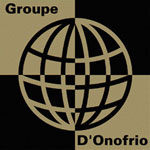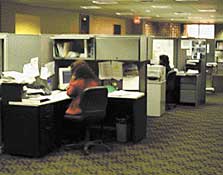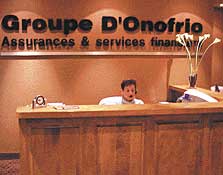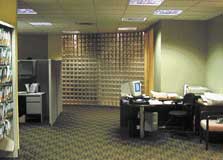
The Montreal Gazette, December 11, 2002
Group D’Onofrio’s success is based on the family values of its patriarch
By Warren Perley
 PHOTO: MARCOS TOWNSEND
Joseph D'Onofrio came to Canada from Italy in 1956 as a young boy, settling into the Villeray district of Montreal. He founded D'Onofrio and Associates in September 1976, and, together with his wife and children, has steadily nurtured the business over the years. Group D'Onofrio is now the fastest-growing insurance broker in Quebec.
PHOTO: MARCOS TOWNSEND
Joseph D'Onofrio came to Canada from Italy in 1956 as a young boy, settling into the Villeray district of Montreal. He founded D'Onofrio and Associates in September 1976, and, together with his wife and children, has steadily nurtured the business over the years. Group D'Onofrio is now the fastest-growing insurance broker in Quebec.
Joseph D'Onofrio came to Canada from Italy in 1956 as a young boy, settling into the Villeray district of Montreal. He founded D'Onofrio and Associates in September 1976, and, together with his wife and children, has steadily nurtured the business over the years. Group D'Onofrio is now the fastest-growing insurance broker in Quebec.
To understand the secret of its success, the first thing you should know about Group D’Onofrio Insurance and Financial Services is that it is family owned and that its staffers take care of their clients in a very personal way.
A first-time visitor to the office is immediately struck by the friendliness of their staff, starting with the receptionist. A middle-aged blonde lady enters the reception area with her 20-something daughter who is holding a baby. An employee sitting nearby is immediately on her feet and walking toward them “You’re so cute,” she coos, eyeing the baby. “What a smile and blue eyes, too.” The trio of visitors is immediately ushered in to the office of Lina D’Onofrio, 29, one of the three children of the president and founder, Joseph D’Onofrio, who works in the business with her father and mother, Zina. The D’Onofrio sons Paul, 33, and Marc, 32, are also involved.
D’Onofrio, who emigrated from Italy with his family as a 10-year-old in 1956, has never lost the immigrant work ethic – he is available to his clients day or night, weekday or weekends. He has also never lost sight of the family values – open-mindedness and honesty – in his dealings with clients and staff. The trust, affection and respect that his staff holds for him are readily apparent. Some call him Mr. D., others Mr. D’Onofrio. It’s like being in the home of an extended family where all the members like each other and work closely together, albeit a family which speaks many different languages. In total, the staff is conversant in 10 languages – French, English, Italian, Greek, Portuguese, German, Spanish, Chinese, Vietnamese and Cambodian.

This cohesive environment and caring attitude has helped make Group D’Onofrio the fastest-growing insurance broker in Quebec – No. 15 among about 6,000 licensed brokers. Across Canada, which has more than 20,000 licensed brokers, Group D’Onofrio is the 29th largest.
Since the three D’Onofrio children became involved in the business between 1992 and 1997, annual revenues have jumped from $4 million in 1997 to $30 million this past year. By 2004, the company projects business will be $50 million annually.
The rapid expansion has necessitated several office expansions in recent years, the most recent one coming this past November 1st when the company bought an entire building at 3750 Cremazie Blvd., occupying one floor of 20,000 square feet. For the two previous years, the company had rented 11,000 square feet at 8500 Langelier Blvd.
At 6 foot, 3 inches and with his dignified manner, D’Onofrio evokes images of former Montreal Canadiens star Jean Beliveau. He has a calm demeanor, speaks softly and chooses his words with care.
Hardship was no strangerThe roots of his success can be found in his childhood. His dad, Dominico, who arrived in Montreal in 1952 from the small village of Lupara in the Molise region of Italy, had saved enough money within four years to send for his wife, daughter and son to join him.
 PHOTO: MARCOS TOWNSEND
On display in the Group D'Onofrio offices is a coat of arms that traces the family tree back to the 9th century in Messina, Italy.
PHOTO: MARCOS TOWNSEND
On display in the Group D'Onofrio offices is a coat of arms that traces the family tree back to the 9th century in Messina, Italy.Theirs had been a tiny village with no modern amenities – no televisions and no refrigerators. The D’Onofrios were one of the lucky families. They had a bathroom, but no running water. Several 50-gallon containers provided the water. As one of the only families with a radio, they would run a long extension cord and place it outside so that the neighbours could hear the news.
The next closest town was Campobasso, a “bustling mecca” of 15,000 about 30 kilometres away. A bus traveled between the two villages every second day. Most of their neighbours never traveled as far as Campobasso in their entire lives. Transportation in the village was provided by about 10 cars, two trucks and “lots of donkeys,” D’Onofrio said in a recent interview.
One of the big events of his young life occurred in 1955, the year before he left for Canada, when the worst snowstorm in a century hit his village, blocking all routes. Major snowstorms were an unusual occurrence, and there were no plows available to clear the downfall. Instead, medication was sent from Rome or Naples in a helicopter that landed on the soccer field. The entire village flocked to see the flying contraption. Joseph was one of the lucky ones – the crew gave him a ride.
He remembers being impressed with the ability of the helicopter crew to help save lives by flying in medication. He thought about being a doctor because he had already seen the good works done by a traveling M.D. who ran a clinic at his parent’s boarding house three days a week.
“That (M.D.) was a big profession in my mind,” D’Onofrio recalled. “I wanted to help solve people’s problems.”
All the memories of his young life flooded over him during the 13-day boat trip to Canada around Christmastime 1956. He was leaving behind relatives, friends and a family tree dating back to the 9th century in the Messina area of Sicily.
During the transAtlantic journey, Joseph had a lot of time to imagine what he would find when he arrived in Canada. Based on what he and his sister, who is six years older, had learned in their history classes back home, they expected to see Indians and cowboys in full western garb.
When he first sighted land near Halifax two days after Christmas, he was struck by the vast expanse of snow along the shoreline as far as the eye could see. “It was like a postcard, it looked like a Christmas decoration.”
From Halifax, they took a train to Montreal, where his dad greeted them. Joseph’s first memory of Montreal was the bitter cold. “I had light clothes on; no winter boots and no jacket. I had never seen so much snow.”
It was bone-chilling cold in winter, but the Quebec society Joseph discovered as a child was warm, rich and vibrant. After buying winter clothes for the family, Joseph’s father immediately took them to the new home he had set up for them on Tillemont Street in the Villeray district, where most of his neighbours were Italian immigrants.
Joseph knew two words in English and French – “yes, no, oui, non.” Had he stayed in Italy, he would have been entering Grade 6. But in Montreal, he was enrolled in a French-language school and put in Grade 3 because of his lack of French.
Aside from the social stigma of being the oldest one in the class and a head taller than all the others, Joseph adapted quickly to his new environment. Given its Latin roots, learning French did not pose a major problem for him. By June of his first year, he was able to speak and write, which allowed school authorities to bump him back up to Grade 7 the following September.
The soft “u” in some French words such as “bijoux” gave him some difficulty, but he learned to pronounce it properly after a few well-intentioned slaps from his teacher. In those years, children weren’t coddled – in or out of school. You learned the facts of life on the street and how to take care of yourself.
Hockey, football and soccer were his passion. The boys in the neighbourhood would get together for pickup games, rough-housing and shouting in French, English and Italian. Joseph was no different than every native-born Canadian kid in that era – his hockey idols were Jacques Plante and Maurice “Rocket” Richard.
Alouettes’ quarterback Sam “The Rifle” Etcheverry was at the top of every Montreal football fan’s list. His sports buddies nicknamed Joseph “I Galleti” – “Little Chicken.” With his long, spindly legs, he could run like the dickens, evading tacklers in their pickup games of football on the large grass field near the old Kik Cola plant.
The ‘listening ear’But there was something going on in Joseph’s mind other than sports in those high school years. He was starting to think about what he wanted to do for a career. He had what the Italians call “a listening ear.” People felt comfortable confiding their problems to him. High on his list of potential vocations was the priesthood. He joined a students’ group called Jeunesse étudiante catholique and remained a member between 1961 and 1967, when he graduated from Technologie Laval, where he had studied computers for four years while playing for the football team under coach Pierre Dumont, a former Alouettes’ lineman.
 Sustained business growth resulted in the need for larger premises. In November, Group D'Onofrio bought its own building at 3750 Cremazie Blvd, where it now occupies an entire floor.
Sustained business growth resulted in the need for larger premises. In November, Group D'Onofrio bought its own building at 3750 Cremazie Blvd, where it now occupies an entire floor.

His life took a dramatic turn in the summer of 1967 at the same time that Montreal was at the height of its glory as host of Expo ’67. He was hired by Canadian Bechtel to go to northern Ontario to draft field revisions for electrical plants being built to supply electricity to area mines.
D’Onofrio stayed with that job between June 1967 and November 1968. During one of his trips to Red Lake, he met an attractive, young English teacher studying in Winnipeg. By the time Bechtel decided to transfer him to Churchill Falls in November, 1968, he and his wife-to-be, Zina, were already engaged.
There was no way they were going to move to the new job in the isolated community of Labrador. Instead, D’Onofrio resigned and the two were married in Montreal in December, 1968.
Zina, whose ancestry is half Lithuanian and half German, encouraged her husband to take a job he saw advertised as a life insurance agent for Great West Life. He was hired, trained and placed in the company’s Place Bonaventure office.
Within three years, he had been promoted to assistant manager and had come to the attention of a rival company, Commercial Union, where he was named branch manager in 1972.
One of D’Onofrio’s distinguishing characteristics throughout his career has been his ability to listen well and respond to needs. People like him – clients, staff and, in the days before he started his own company, bosses. He is organized and always takes the time to do the right thing.
This attention to detail and the excellent personal relationships he cultivated paid off big time in 1976 when Commercial Union decided to withdraw from the Quebec market.
Buys a business for $1Rather than just shut down its Quebec premises, Commercial Union offered D’Onofrio its client list, equipment and about $50,000, representing six months of severance, to take over the business in exchange for $1. In September, 1976, Joseph D’Onofrio & Associates was born.
Zina, who had been teaching English to primary students in French schools, quit her job to become a broker for general insurance. Joseph concentrated on selling life insurance and financial services.
 PHOTO: MARCOS TOWNSENDA family business, Group D'Onofrio places a lot of importance on treating clients efficiently, with friendliness and respect. Shown here from left to right are wife Zina, daughter Lina, sons Marco and Paul, and Joseph D'Onofrio.
PHOTO: MARCOS TOWNSENDA family business, Group D'Onofrio places a lot of importance on treating clients efficiently, with friendliness and respect. Shown here from left to right are wife Zina, daughter Lina, sons Marco and Paul, and Joseph D'Onofrio.D’Onofrio’s life-long networking activities began to pay off – from his school-day contacts at Jeunesse étudiante catholique to his community involvement in the Optimist Club, in Baseball Quebec and in the Canadian-Italian Community Services. Together with his own life-insurance contacts, these connections led to a snowballing of the general insurance business.
Despite their growing business, when their lease ended a few months later in Westmount, D’Onofrio and his wife moved to a 1,000-square-foot office on Jarry Street near St. Hubert where the rent was more affordable.
By this time, he and his wife had three young children and not enough hours in the day for both family and business, so in 1978 they decided to move the office into the basement of their Bois des Filion home.
Between 1978 and 1981, the two of them worked out of their basement, combining work with family life. Joseph was on call day and night, seven days a week, visiting clients to answer their questions about life insurance and investment needs.
They would ask him common investment questions such as what is a mutual fund, how to calculate and increase net worth, how much should be saved from weekly salaries, how to maximize RRSP contributions and the Rule of 72.
(The Rule of 72 is a simple rule of thumb for estimating how quickly assets will grow. Take the number 72 and divide it by your rate of return – this will tell you how long it will take to double your assets. If you are earning 8 per cent, your assets will double every 9 years – 72 divided by 8.) Common insurance questions he faced were:
- Is my insurance coverage adequate?
- What is “one way” insurance?
- Is a home-based business covered under a residential policy?
- Does insurance cover a power failure that lasts several days?
- Should additional insurance be taken out for specific, valuable items in the house?
- Should I have insurance against sewer backup?
- Why should I take out insurance against earthquakes?
- If I borrow someone else’s vehicle, is the damage caused to that vehicle covered by my insurance policy?
By 1981, Joseph and his wife decided that they needed to hire more people to help them in the business so they moved to a 2,800-square-foot office on Gouin Blvd. where they stayed until they moved to Langelier in 2000.

By that time they had 70 employees and were placing business with ING, one of the largest banks and insurance companies in the world. It was during this period that D’Onofrio made his next huge business breakthrough, once again a result of the excellent people skills he had honed dating back to childhood.
Dennis Furlong, vice-president of finance for ING at that time and now president of the company’s eastern region, would drop by for one of D’Onofrio’s famous espresso coffees and to chat about business. He liked what he saw of the D’Onofrio work ethic. What Furlong saw at the D’Onofrio home office convinced him that he wanted to forge a closer working relationship with the husband-wife team.
“Mr. Furlong saw that we worked hard as a family operation and that we placed a lot of emphasis on honesty and service,” D’Onofrio recalled of those first meetings. “I think he also liked the coffee,” he added with a smile.
Furlong continued to keep an eye on their progress and the increasing amount of business that Group D’Onofrio was sending ING’s way.
Finally, in 1997, Furlong made D’Onofrio an offer he could not refuse – ING would back D’Onofrio financially to buy out other brokers who could benefit from working under the D’Onofrio banner.
Encompassing 20,000 square feet, Group D'Onofrio's new offices provide a spacious, modern business environment that clients and employees appreciate.
 Encompassing 20,000 square feet, Group D'Onofrio's new offices provide a spacious, modern business environment that clients and employees appreciate.
Encompassing 20,000 square feet, Group D'Onofrio's new offices provide a spacious, modern business environment that clients and employees appreciate.

Once again, D’Onofrio’s extensive industry contacts, his ability to listen and his sterling reputation for honesty and fairness came to the fore. One after another, Group D’Onofrio began buying up other brokers, creating a win/win situation whereby the brokers were paid for their businesses, but then came to work for D’Onofrio where they could concentrate on servicing clients while D’Onofrio took care of the infrastructure and administration. The resulting growth has been nothing short of spectacular.
Yet even with the continual expansion necessitated by his burgeoning business, some things never change. For example, D’Onofrio avoids using his voice mail, preferring to take all his phone calls whenever possible. He still treats his employees like family, making annual home barbeques where he, his wife and children cook for the entire staff.
In turn, his staffers still visit clients at their homes to discuss insurance and investment needs, just as D’Onofrio did in the old days when he worked out of his basement.
D’Onofrio stays very active in community affairs. He is on the board of governors for the Santa Cabrini Foundation, as well as the boards of the Italian-Canadian Community Services of Quebec and the Islemere Golf Club. As of September 2002, he took over as president of the Mount Stephen Club, a private organization for businessmen.
True to his childhood experience growing up in a small Italian village and then as an immigrant in the close-knit Villeray district of Montreal, D’Onofrio believes that community is everything and that the benefits of success should be shared.
Warren Perley, a former career journalist, is president of Ponctuation Grafix, a marketing and graphic design studio (www.ponctuation.com).